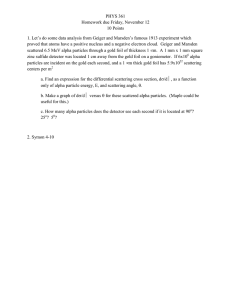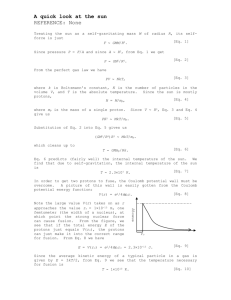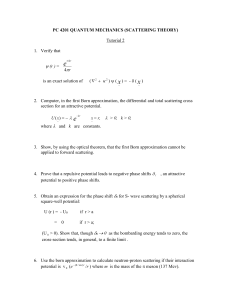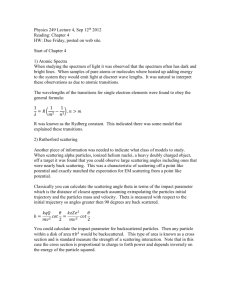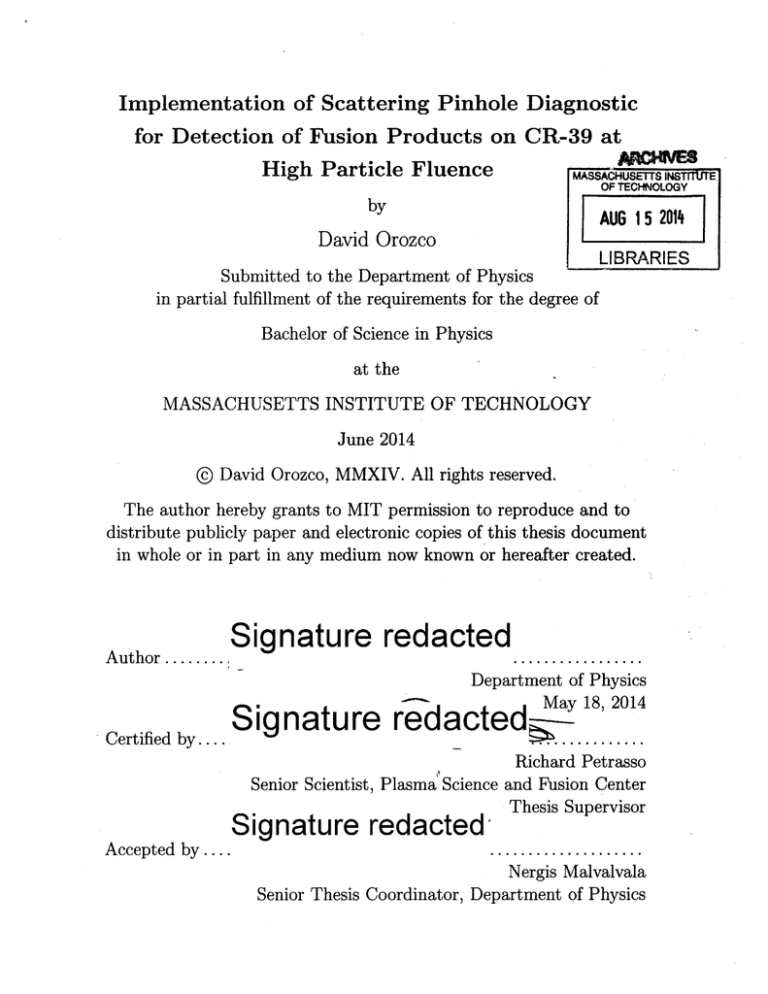
Implementation of Scattering Pinhole Diagnostic
for Detection of Fusion Products on CR-39 at
High Particle Fluence
AMOVEMS
MASSACHUSmETr INSiTITE,
OF TECHNOLOGY
by
AUR
15 20
David Orozco
LIBRARIES
Submitted to the Department of Physics
in partial fulfillment of the requirements for the degree of
Bachelor of Science in Physics
at the
MASSACHUSETTS INSTITUTE, OF TECHNOLOGY
June 2014
@ David Orozco, MMXIV. All rights reserved.
The author hereby grants to MIT permission to reproduce and to
distribute publicly paper and electronic copies of this thesis document
in whole or in part in any medium now known or hereafter created.
Author ........
Signature redacted
Department of Physics
May 18, 2014
Certified by....
Signature redacted-...
. ...........
Richard Petrasso
Senior Scientist, Plasma Science and Fusion Center
Thesis Supervisor
Signature redacted.
Accepted by ....
Nergis Malvalvala
Senior Thesis Coordinator, Department of Physics
2
Implementation of Scattering Pinhole Diagnostic for
Detection of Fusion Products on CR-39 at High Particle
Fluence
by
David Orozco
Submitted to the Department of Physics
on May 18, 2014, in partial fulfillment of the
requirements for the degree of
Bachelor of Science in Physics
Abstract
Many Inertial Confinement Fusion (ICF) experiments use solid-state nuclear track
detector CR-39 as a means to detect different types of nuclear products. Until recently, it was difficult to use CR-39 in experiments with very high yields because
particle tracks would overlap. A scattering pinhole has been implemented in order
to reduce the fluence on the CR-39. This paper details the design and implementation of a scattering pinhole to detect protons born from D3 He nuclear reactions:
D +3 He = p+(14.7MeV) + a(3.7MeV). To do so, basic models relating the scattering angle to material thickness and atomic number were developed. The scattering
pinhole reduced the fluence on the CR-39 enough to successfully count all the tracks
and calculate a product yield. A proton yield of 2.25e10 t 0.17e10 was calculated
and falls within half a standard deviation of the proton yield found with the Wedge
Range Filter (WRF) spectrometer, the value being 2.19e10. The image on the CR-39
was predicted to be s = 0.957mm t 0.092mm. This correlates with measured size
- = 0.873mm, supporting the validity of the models. To further explore the nuclear
this nuclear reaction, the design challenges for detecting 3.7MeV alpha particles was
also explored.
Thesis Supervisor: Richard Petrasso
Title: Senior Scientist, Plasma Science and Fusion Center
3
Acknowledgments
This is the acknowledgements section. You should replace this with your own acknowledgements.
4
Contents
1
Introduction
11
2 Background (Theory and Technical Details)
3
2.1
Nuclear Fusion
2.2
Burning in ICF . . ..
. . ..
. ..
15
. . . . . . . . . . . . . . . . . . . . . . .
15
. . . . . . . . . . . . . . . . . . . . . . . .
18
2.3
Measurement Techniques . . . . . . . . . . . . . . . . . . . . . . . . .
20
2.4
Scattering Pinholes . . . . . . . . . . . . . . . . . . . . . . . . . . . .
21
..
Design and Experimental Setup
23
3.1
28
Alpha Exploration
. . . . . . . . . . . . . . . . . . . . . . . . . . . .
4 Results
29
5
33
Conclusion
5.1
General Sources .......
. . . . . ..
5
. . . . . . . . . . . . . . . .
36
6
Plasma contained in a toroidal field inside a tokamak
12
1-2
Indirect Drive Depiction . . . . . . . . . . . . . . .
13
2-1
Coulomb Barrier and Strong Interaction Well
2-2
Binding Energy Curve . . . . . . . . . . . . . . . .
17
2-3
ICF Burn Depiction
. . . . . . . . . . . . . . . . .
18
2-4
Rayleigh-Taylor instability in capsule . . . . . . . .
19
2-5
Overlapping Tracks on CR-39 . . . . . . . . . . . .
20
2-6
Scattering Foil Diagram
. . . . . . . . . . . . . . .
22
3-1
Particles Striking Pinhole Substrate . . . . . . . . .
24
3-2
Proton Transmittance through Scattering Foil . . .
24
3-3
Scattering Angle vs Scattering Foil Thickness
. . .
26
3-4
Scattering Angle vs Z of Scattering Foil . . . . . . .
27
3-5
Alpha Particle Transmittance through Scattering Foil
27
4-1
Image of proton tracks on the CR-39 . . . . . . . .
30
4-2
Microscope Frame of CR-39 . . . . . . . . . . . . .
31
4-3
Proton Counts..........................
32
.
1-1
.
List of Figures
.
.
.
.
.
.
.
.
.
.
.
. . .
7
. . . . . . . .
16
8
List of Tables
3.1
Data table displaying the desired area and the actual area, along with
the error on the area. . . . . . . . . . . . . . . . . . . . . . . . . . . .
9
25
10
Chapter 1
Introduction
Fusion of hydrogen and its isotopes has been identified as a possible alternative energy source. Unlike its nuclear counterpart, fission, fusion produces less radioactive
byproducts. Hydrogen isotopes, the favored fusion material, has the highest energy
density of all the elements[1] and are the most abundant elements in the universe.
The process of fusion was first detailed by Atkinson and Houtermans in 1929.
The process was used to describe how stars are fueled; this won Hans Bethe the 1967
Nobel Prize in Physics. Fusion was quickly employed for military applications and it
was Enrico Fermic who, in 1941, proposed a hypothetical method of achieving fusion
with a fission reaction. Because of this, much of fusion research was classified and not
open to the public. It wasnt until the 1950s that information was openly disclosed.
Fusion involves the confinement and control of plasma. Two methods of doing this
are magnetic confinement and inertial confinement.
Magnetic confinement fusion
(MCF) occurs by trapping plasma in magnetic fields as the name suggests.
The
plasma is then heated up, with the use of radio waves, until fusion occurs. This
requires temperatures over ten million degrees Celsius. MCF fusion is predominantly
achieved with a Tokamak, a large toroid that confines a plasma within its volume.
Tokamaks generate toroidal magnetic fields to confine plasmas as shown in Fig 1-1.
One can imagine a whirling star inside a tokamak that has achieved fusion.
Inertial Confinement Fusion (ICF) works by imploding a small capsule, approximately 1mm in diameter, of fusionable material. A sudden laser burst causes the
11
Poloidal field
magnet
Toroidal field
ma
n et
Figure 1-1:
The above shows how magnets are
mak to produce a toroidal field to confine plasma.
/ science.howstuffworks.com/fusion - reactor3.htm
Vacuum
chamber
arranged in a tokaImage from http
capsule to rapidly implode (to a size on the order of 50 microns) increasing the density
and the temperature of the fuel high enough to achieve fusion[4]. There are two ways
of imploding these tiny capsules: directly and indirectly. Direct drive involves aiming
the lasers at the capsule and indirect drive involves aiming the lasers at a cylindrical
vessel where the capsule awaits as in Fig 1-2. The cylinder then produces X-rays that
compress the capsule enough to achieve fusion.
Currently there are two large laser facilities in the United States that perform
laser driven ICF: the National Ignition Facility (NIF) in Livermore, California and the
OMEGA Laser Facility in Rochester, New York. Both facilities work towards better
understanding the fusion process to, ultimately, use fusion as an energy source[5].
Fusion, when its applications were first being considered, did not seem like a very
difficult achievement. Once physicist began constructing fusion devices, it became
more and more apparent that fusion would not be easily accomplished. Plasma dy12
Figure 1-2: The above a capsule inside a cylinder. The cylinder is hit by a laser
pulses and produces X-rays that compress the capsule to achieve fusion. Image from
Lawrence Livermore National Laboratory
namics are very complicated and there are many instabilities associated with plasmas.
Fusion plasmas are composed of many energetic particles that can, and most likely
will, damage surrounding objects. The ICF process is quite literally a controlled explosion. To study and understand these plasmas we need to be able to observe and
detect many different aspects of the plasmas and their fusion products.
Therefore there are limited diagnostic tools that can be used in these facilities to
make measurements. Finding effective methods of making measurements is still an
active issue. One prominent method of particle detection in ICF involves the use of
a plastic, CR-39. CR-39 is a clear plastic made up of long molecular chains. When
particles strike the piece of CR-39, they leave conical damage trails. The CR-39 is
then etched, increasing the diameter of the damage trails, allowing one to observe
the damage trails under the microscope. By counting the number of tracks (done
13
by a computer program), one can determine how many particles were produced in
the fusion process[7]. By properly applying filters, we know what particles we are
observing.
This process, though, comes with its own difficulties. Particles are undercounted
when so many particles strike the CR-39 that they overlap. Experiments at NIF
and OMEGA can yield a very high number of products causing significant track
overlap and error in the results. Recently, a method of reducing the fluence on the
CR-39 has been developed in order to find the yields by directly measuring fusion
products[9]. The method makes use of a pinhole and Rutherford Scattering to deflect
a smaller number particles over a greater area on the CR-39. This has been done
successfully to measure protons that were created by fusing Deuterons together. The
following experiment successfully measure the yield of 14.7MeV protons produced at
the OMEGA laser facility.
14
Chapter 2
Background (Theory and Technical
Details)
2.1
Nuclear Fusion
Nuclear fusion is a physical phenomenon that occurs when nuclei get close enough
together that their nuclei overcome the Coulomb barrier and fall into the potential
well governed by the strong force. The nuclear force is also called the strong force
because it is several orders of magnitude larger than the electromagnetic force. Unlike
the electromagnetic force, though, the nuclear force does not follow a simple inverse
squared law. Instead the nuclear force overwhelms the Coulomb force at scales of
approximately 1 femtometer and then drops off exponentially. The nuclear force is
detailed in quantum chromodynamics and is easier to think of as a force that takes
over at very short length scales as seen in Fig 2-1. The energy of the system, in
this case just two nuclei (can be two hydrogen atoms), is E. Classically this reaction
cannot occur unless E is greater than the potential peak. But quantum mechanics
describes how particles can tunnel through a barrier with a finite probability. By
increasing the energy of the system, it is more and more likely that a particle will
tunnel past the Coulomb barrier to a bound state due to the Strong Interaction.
Once the atoms fuse, there is a change in mass that is accounted for by mass-energy
equivalence E = mc2 : the fusion process does not conserve mass in the Classical sense
15
E
6
\
System Energy E
-
A
Coulmb otential
Potential Well Due
to Strong
U
-Interaction
Figure 2-1: The system energy E is not enough to overcome the Coulomb barrier.
Classically this fusion reaction cannot occur unless E is larger than the peak of the
potential. But, as described by quantum mechanics, the system can tunnel past the
Coulomb potential and achieve fusion. The system then gains energy related to the
difference in mass before and after the fusion reaction.
and therefore some of that mass is released as kinetic energy. This kinetic energy is
carried by the fusion products. For example, fusing deuteron with a triton produces a
14.1MeV neutron and a 3.5MeV alpha particle. If we sum up the mass of the deuteron
and triton and compare it to the mass of the neutron and alpha particle we find a
mass difference of 17.6MeV/c 2 . This unit system uses c = 1 so the energy ends up
being 17.6MeV, the sum of the products energy.
In facilities such as NIF and OMEGA the focus is on fusion using capsules with
different amounts of tritium, deuterium and Helium-3. As nuclei get larger, the energy
that is released during fusion tends to fall lower and lower so it is not favorable to
pursue higher Z reactions. Beyond Z = 26, fusing atoms together consumes more
16
nu4tu
energy than is released in the process. Fig 2-2[1-)] shows energy relates to atomic
mass and how fusing low Z atoms releases significantly more energy than breaking
apart high Z nuclei.
Fe
8
-
6
nuclear Itssirn
- 28 N6Ni (momt 1101tY bound)
9I
26
Elemorts bewevr
e
Fe
than ion can yiel
energy by nuclar
26 have 8.8 Me, V
fission.
u
1C
E
yieldfrom
of Wsoopes are the
MWs lightly bound,
4|-
bdng energy.
yield from
nucear fusion
2
-Average mass
of fision frugroent
is abouI 118.
235
I
150
100
50
k
200
Mass Number, A
Figure 2-2: Binding energy increases quickly to a plateau point (Iron) and then drops
down slowly. [t 01
For the purposes of this paper, the main reactions observed are the following:
D +3 He
D+ D
D+D
-+
-
o[3.6MeV] + p+[14.7MeV]
(2.1)
T[1.01MeV] + p+ [3.02MeV]
(2.2)
n[2.45MeV] +3 He[O.82MeV]
(2.3)
-a
Where D represents deuterons, T Tritons, a Helium (alpha particles), p Hydrogen (protons), and n neutrons. The capsule used in these experiments contained
deuterium and Helium-3 so it is necessary to consider all the possible products except
the neutrons (they do not cause tracks on the CR-39).
17
2.2
Burning in ICF
As mentioned before, ICF fusion is driven by lasers that are focused on a small
capsule containing fuel. This capsule is made up of a plastic ablator that surrounds
Deuterium-Tritium (or some other mixture of fusionable material) ice. The center
of the capsule is hollow, and contains a gas, also fusionable material. The idea is to
compress the capsule, increasing the density of the ice and gas enough so ignition will
occur. Ignition in the specific case when fusion initially begins at the center, with the
gas, and the burn propagates outward fusing all of the material Fig 2-3.
Figure 2-3: The above shows how a capsule burns would ideally burn. In a) laser
energy is incident on the capsule; in b) the plastic shell is ablated and momentum is
transferred to the capsule, causing an initial propagating wave; c) the radius of the
capsule decreases as the density increases; d) the center of the ignites and a burn
wave propagates outward. Image made by Benjamin D. Esham
Ignition has yet to be achieved due to instabilities that occur in the driving process.
Surface imperfections of the capsule and non-uniform laser input cause fuel to burn
non-uniformly. A major instability is the Rayleigh-Taylor instability. This instability
occurs when hotter, lighter fluid pushes against colder, denser fluid. Fig 2-4[G] shows
how the material on the inside moves outward, past areas in the sphere that cannot
contain the plasma.. These issues prevent all the material from being fused therefore
more energy is put into the process than is taken out.
One method to help deal with laser-induced instabilities is the indirect drive
method mentioned earlier. Direct drive shines many lasers on the ablator, and these
lasers do not heat uniformly. Each laser essentially creates a small hotspot on the
shell therefore creating an instability. Indirect drive instead aims the lasers at a gold
18
0. 5Oneec
60
c 40
20
0
20
40
C I0
80
D I atence(pm)
Figure 2-4: The above image shows the Rayleigh-Taylor instability in a pusher
experiment[G]. The hot gas in the center has been heated up and escapes through
regions of the capsules that are less dense.
cylinder (hohlraum) that surrounds the capsule. When the lasers strike the gold,
they become x-ray sources that shine on the capsule more uniformly. This eliminates
the instabilities due to lasers, but now an instability is created due to the lasers.
Indirect drive produces an overall instability that deforms the capsule, while direct
drive causes many, small instabilities.
To combat the instabilities in indirect drive, physicists are designing curved hohlraum.
Therefore it is very important that effective diagnostics are developed so physicists
can understand the instabilities that occur in the fusion process in order to improve
the ICF fusion process overall to achieve ignition.
19
2.3
Measurement Techniques
The efficiency of the nuclear reactions are determined by the products and their yields.
In general, a lot of knowledge has been gained by observing fusion reactions. This
has placed considerable significance in developing methods of detecting the nuclear
products. CR-39 solid-state-track detectors have become a prevalent form of measuring charged particles. It is a type of plastic made up of long, molecular chains
that can be broken by incoming particles. By etching CR-39 in NaOH, the tracks
become visible under a microscope and circular-appearing tracks can be counted by a
computer-driven scanning microscope. Extensive work has been done in understanding CR-39 response; track diameter depends on etch time, particle species, particle
energy, and even time left out at ambient temperature[7][8]. Longer etch times create larger tracks; different particles lose energy at different rates and rate of energy
loss is dependent on energy (it is routinely used to measure protons with energies
ranging from 0.5 to 8MeV); and CR-39 tracks are more likely to deform at higher
temperatures.
Sngl tracks
counted
Overlapping tracks
not counted
Figure 2-5: The tracks in frame a) are well separated and can all be individually
counted. Tracks in frame b) are so close together that they overlap and are not
counted by the computer-driven scanning microscope[9).
If too many particles strike the piece of CR-39, holes will begin to overlap and
20
the number of holes will not be undercounted. The left image of Fig 2-5[9] shows
a frame of the microscope. This frame shows how the holes are spread out enough
so they can be counted successfully (yellow dots).
The right image on the other
hand contains many holes and the red tracks are overlapping holes that the computer
interprets as noise. Therefore inferred yield from these results end up being much
smaller than actual yield. The fluence (tracks per cm2 ) at which this becomes a serious
problem, for the purpose of this experiment, is approximately 10 6 cm- 2 . The amount
of particles created in these experiments is on the order of 10" where the length scale,
distance from the implosion to the detector, is approximately 20cm to 30cm. A quick
calculation over the surface area of a sphere shows that these experiments fall right
into this regime where it becomes difficult to effectively resolve the particle tracks.
It is unpractical to reduce the fluence on the CR-39 by simply increasing the length
scale. This would require alteration of the physical system. Furthermore, the yield
for such experiments is only increasing due to the continual successes made in the
field. This would cause a constant issue with building larger facilities for increasing
yields. Hence, a new method of reducing the fluence on the CR-39 within the current
size constraints is essential.
2.4
Scattering Pinholes
A method has been developed in order to efficiently use CR-39 to observe the fusion
products in high yield conditions. The method is depicted in Fig 2-6. A pinhole
is used to limit the number of particles that enter the detector. Placed behind the
detector is a foil that scatters the incoming particles. The scattering phenomenon
is well known as Rutherford scattering. Incoming particles will take a random walk
through the material and when they exit they will fly off in different directions. If the
travel length after the pinhole is long enough, the particles will be sufficiently spaced
that they will not overlap. The fluence reduction factor can be determined by the
geometry of the system and the scattering angle of the foil. So if we have a fluence
F on the front of the detector, the reduction factor RF is determined by
21
Pinhole with
Diameter d
L
Pinhole
Substrate
CR-39
Source
Scattering Foil
Figure 2-6: The above shows the basic arrangement of the scattering pinhole. The
number of incoming particles is limited by the area of the pinhole and the particles
are dispersed by the scattering pinhole. The particles enter the foil and are spread
by Rutherford scattering as shown in the zoomed in cartoon. The particles leave the
foil with an average angle 9 and spread over a larger area on the CR-39.
2
RF= 4L (tan 0)2
(2.4
Where L is the distance from the source to pinhole, d the diameter of the pinhole,
and 9 the scattering angle. With this value, the fluence on the CR-39 is given by
Ff = F/RF-
22
Chapter 3
Design and Experimental Setup
In order to detect the protons in reaction (1) the fluence on the CR-39 was reduced
from the fluence on the pinhole. The experiment occurred at OMEGA and the physical size of the detector package constrains the distance at which the scattering pinhole
apparatus is placed. From this, the design options are: material to use as the pinhole
substrate; material to use as the scattering foil; thickness of materials; and diameter
of the pinhole.
Fig 3-1 depicts how the pinhole substrate from Fig 2-6 works in more detail. It
is the main form of eliminating the incoming noise and what limits the number of
particles that strike the CR-39. Fig 3-2 shows how the scattering foil also filters out
unwanted particles and only allows the 14.7MeV protons through. The foil will not
only scatter the protons but reduce their energies. CR-39 is most efficient at detecting
particles with an energy range between 0.5MeV and 8MeV[7] so it is important that
the foil is also thick enough to lower the energy of the protons enough.
With the use of TRIM [t 2], a software simulation package, a relationship between
the thickness of a material and the average angle 6 was determined for various materials Fig 3-3. These curves are specific to 14.7MeV protons. The effect of atomic
number is also another important relation Fig 3-4. From these sets of graphs it is
quite likely that 0 (x Z vThickness.
In order to stop the 14.8MeV protons, 750pm of Tantalum was used as the pinhole
substrate, and, to gain a good scattering angle, 406pm of Copper was used as the
23
-
14.7MeV D3He-p
3.6MeV D3He-a-
Not to Scale
-
1.01MeV DD-T
-
3.02MeV DD-p
-
0.82 MeV DD-He
Figure 3-1: The above shows how the pinhole substrate is meant to stop all the
incoming particles. The image shows relative stopping length.
14.7MeV D3He-p
0.5 - 8MeV
3.6MeV D3He-a
-
1.01MeV DD-T
3.02MeV DD-p
-
0.82 MeV DD-He
Figure 3-2: The above shows how the scattering foil not only scatters the D 3 He
protons but also filters out other particles. It is important that the protons leave the
foil with an energy between 0.5MeV and 8MeV[7].
24
scattering foil.
Copper has Z=29, compared to the Nickels Z=28, and was used
instead for convenience. This foil gives a scattering angle of approximately 7'. The
simulations also showed that the protons would exit the copper foil with an energy
of 6MeV. This energy is low enough to cause noticeable tracks in the CR-39[7].
To achieve a reduction factor of approximately 50, the diameter d of the pinhole
was chosen to be 3 00ptm. The distance from the CR-39 to the front of the camera is
constrained at 8.9mm. Therefore a spacer of 7.8mm was 3D printed out of ABS (a
common plastic) in order to constrain the scattering foil onto the pinhole by pressure
caused by spring-loaded encasement. This gives an expected reduction factor of 53
based on equation (4), with L = 7.8mm, 0 ~ 7', and d = 0.3mm.
The pinhole was machined with microdrills. Burrs on the edges of the hole make
the aperture imperfect, and noncircular. To account for this, pictures were taken of
the holes under a microscope with 40x magnification. The images were then downloaded into a computer aided design (CAD) program. The program allowed the image
to be scaled properly, cropped, and processed to find the results in Table 1.
Actual
Uncertainty
Area (mm2 )
Area (mm 2 )
(mm 2
0.0707
0.08679
0.0066
)
Desired
Table 3.1: Data table displaying the desired area and the actual area, along with the
error on the area.
The error was determined by extremizing cropping choices and is the error on the
actual area. The actual reduction factor was approximately 36. Though this is not
the desired value, its enough to bring down the fluence sufficiently to read the tracks
with 100% detection efficiency.
The materials were packaged together and placed inside the vacuum chamber
at the OMEGA laser facility The experiment shot number is 71551. The capsule
contained Deuterium and Helium-3.
25
Average Scattering Angle as a function of Thickness for Various Material
(I)
0
0
L..
0)
0
Q
-Be
-Al
Ni
-Ta
U
151
10
4-'
0
-c
I-
5
0
200
400
600
800
1000
Thickness (microns
1200
1400
Average Scattering Angle as a function of Thickness for Be(4)
I . AI
(0
0
0
1~
0)
0
1[*
0
(U
0
4-'
-c
H
0.5F
0
200
400
1000
600
800
Thickness (microns
1200
1400
Figure 3-3: The top graph shows how the average scattering angle 9 changes as a
function of the material thickness for various materials for 14.7MeV protons. By
taking a closer look at the relationship for Beryllium it seems like 9 oc A/Thickness.
26
Average Scattering Angle as function of
Atomic Number for Various Thicknesses
15F -T
-T
= 20pm
= 40pm
0
0>
T = 8pm
10-T = 16pm
0
T = 320pm
I-
r
LI
I
0
20
60
40
Atomic Number (Z)
80
100
Figure 3-4: The above show how the scattering angle is also affected by atomic number
(Z). It is quite likely that there is a linear relation between the two.
14.7MeV D3He-p
t",14MeV
3.6MeV D3He-a
1.01MeV DD-T
3.02MeV DD-p
0.82 MeV DD-He
Figure 3-5: The D 3 He alpha particles from reaction (1) have an energy similar to
the DD protons from reaction (2). The energy gap between Tritons and the alphas
is also rather small. The above shows an ideal situation where only the D3He alphas
and the DD protons get through at an energy that can be detected by the CR-39.
27
3.1
Alpha Exploration
Fig 3-5 depicts an ideal situation for a scattering foil that would allow the detection
of alpha particles. The challenge here is the alpha particles that have an energy very
close to the energy of other particles that are created in the fusion process. With
the 14.7 MeV protons it was simple enough to filter all other particles because of the
difference in energies. It needs to be made sure that the 1.01 Tritons from reaction
(2) and 0.8 Helium atoms from reaction (3) are successfully filtered out.
Filtering out the DD protons might not be achievable; alphas, for a given energy,
are stopped with less material than protons but in this case the protons have less
energy than the alphas. Therefore it is important that the DD protons and D 3 He
alphas have distinct scattering angles to help distinguish the two signals on the CR39. To account for the additional particles, a larger reduction ration would also be
necessary to ensure the proton tracks and the alpha tracks do not overlap.
Finally, the D 3 He protons must be accounted for. Since the CR-39 efficiently
picks up tracks with energies between 0.5MeV and 8MeV, as long as the energy of
these protons are high enough, they should not present a problem.
28
Chapter 4
Results
Once the CR-39 was received, it was etched for 2 hours in NaOH at a temperature of
8000. The CR-39 was then placed under a computer-driven scanning microscope that
counted the tracks. The software itself does not completely discern all noise of the
CR-39 and required additional processing. Fig 4-1 shows the processed image. Each
pixel in the pictures corresponds to a frame under the microscope ( 300pmx400jm)
like the one in Fig 4-2. The brighter the pixel in Fig 4-1the more holes there are
in the pixel. From both images we can discern that there is a good concentration
localized in a single region with minimum noise and good separation between holes.
Therefore we can trust the number of tracks found by the computer program.
To determine the yield, the tracks were parsed into bins as in Fig 4-3. The data
follows a Gaussian profile in horizontal space. From the fit the number of tracks under
the Gaussian was determined to be N = 2142 tracks. An estimate for the number of
D3 He protons produced during the fusion process was calculated with the following
equation:
47rR2 N
YD3He
(4.1)
Aph
Where R is the distance from the source to the pinhole and Aph is the pinhole
area. It was found that
YD3He =
2.26e10
following equation:
29
0.17e10. The error was found with the
Figure 4-1: Image of proton tracks on the CR-39. The scan is done at 40x magnification and by specialized software that counts how may holes there are in each frame.
Each frame corresponds to a pixel in the above images.
2
\Y
\N
=
(DY
AN 2
AN 2
OR
Dy
OY
2
+-
4.2
A2h
DAph
p
ANBKGND + AN 2tat
(4.3)
The first term under the square-root corresponds to the uncertainty in our value
of N; the second to the uncertainty in the distance from the source to the pinhole;
and the third to the uncertainty in the pinhole area. Here ANBKGND
=
100 (the
uncertainty due to choosing different filtering options in the computer program),
ANtat
is the statistical error, AR = 0.75cm is the error in the distance from source
to the pinhole substrate (due to the relatively large thickness of the pinhole substrate),
30
Figure 4-2: The above image shows a single frame of the microscope with 40x magnification. The proton tracks are very well spaced and no overlap is observed.
and AA is the error from Table 1.
An estimate for the 14.7MeV protons was also calculated with Wedge Range
Finder proton spectrometry (WRF). This method estimated the yield to be 2.19e10.
The WRF prediction is less than half a standard deviation away from the calculated
yield using this experiment, supporting the validity of the estimate.
From Fig 4-3 we find that o = 0.873mm. This length describes the approximate
radius of the image on the CR-39. We had previously chosen the material in order to
get a scattering angle 0 of approximately 70. By using Rtan(O) = s, where s is the
expected radius on the CR-39, we find a value that we can compare to a-. The value
of s = 0.957mm
0.092mm which falls within a standard deviation of the - value
found. Where the error is found with the following equation:
As = ARtan(O)
(4.4)
This not only further confirms the results found but is also an initial point to
verify the relations between scattering angle, material thickness, and atomic number.
31
071551_TN1_ma5258_2h 40x_s2.cpsa (ix=472, iy=64-85)
Gaussian fit for X (cn) = -0.3 to 02997:
mean value = 0.0065157
siga
=
0.087356
FWHM =0.20572
Tracks under Gaussian = 2142.1
3131
-
200
300
-
-100
-200
.
.........
-0.4
-0.3
.
.
-0.2
-0.1
0
X (an) (bin width
0.1
0.2
0.3
0.4
0.0428)
Figure 4-3: Each bin corresponds to a number of pixels on Fig 4-1. The graph was
made to exclude most of the area on the CR-39 that contains a lot of noise. By
applying a Gaussian fit to the above, we get an estimate for the number of proton
tracks on the CR-39
32
Chapter 5
Conclusion
The experiment showed that 14.7MeV protons can easily be observed in high-yield
experiments with the use of a scattering pinhole. By checking our yields with the
WRF results we find that this method is very accurate. This means that the scattering pinhole setup can be used to double check WRF yields, perform experiments
where WRF would not be able to give accurate yields, and possibly to develop more
sophisticated forms of spectrometry. This also calls for the development of models
that can be used to easily choose parameters (material, thickness,etc) for scattering
pinholes.
To further build on this technique, an alpha detector can be built an implemented.
By building better models that not only relate the scattering angle to material thickness and atomic number but also to the energy lost by the particle, the best design
choices can be made.
33
34
Bibliography
[1] "Why Fusion?" Fusion Future. N.p., n.d. Web. 18 Dec. 2013.
[2] Arnoux, Robert. "Deuterium: A Precious Gift from the Big Bang." ITER. ITER,
11 Mar. 2011. Web. 18 Dec. 2013.
[3] "Tritium." EPA. Environmental Protection Agency, n.d. Web. 16 Dec. 2013.
[4] "Nuclear Fusion Power." Nuclear Fusion : WNA. World Nuclear Association,
Dec. 2013.
[5] "NIF: The "Crown Joule" of Laser Science." NIF. Lawrence Livermore National
Laboratory, n.d. Web. 18 Dec. 2013.
[6] Sakagami, H., and K. Nishihara. "RayleighTaylor Instability on the Pusherfuel
Contact Surface of Stagnating Targets." Physics of Fluids B: Plasma Physics
2.11 (1990): 2715. Print.
[7] F. H. Seguin, J. A. Frenje, C. K. Li, D. G. Hicks, S. Kurebayashi, J. R. Rygg,
B.-E. Schwartz, R. D. Petrasso, S. Roberts, J. M. Soures, D. D. Meyerhofer, T.
C. Sangster, J. P. Knauer, C. Sorce, V. Yu. Glebov, C. Stoeckl, T. W. Phillips,
R. J. Leeper, K. Fletcher and S. Padalino, Rev. Sci. Instrum. 74, 2 (2003).
[8] N. Sinenian, M. J. Rosenberg, M. Manuel, S. C. McDuffee, D. T. Casey et al.
Rev. Sci. Instrum. 82, 103303 (2011);
[9] M. J. Rosenberg, F. H. Snguin, C. J. Waugh, H. G. Rinderknecht, D. Orozco,
J. A. Frenje, M. Gatu Johnson, H. Sio, A. B. Zylstra, N. Sinenian, C. K. Li, R.
35
D. Petrasso, V. Yu. Glebov, C. Stoeckl, M. Hohenberger, and T. C. Sangster, S.
LePape, A. J. Mackinnon, R. M. Bionta, 0. L. Landen, R. A. Zacharias, Y. Kim
and H. W. Herrmann, J. D. Kilkenny. Submitted to Rev. Sci. Instrum.
[10] "Nuclear Binding Energy." Nuclear Binding Energy. Hyperphysics, n.d. Web. 18
Dec. 2013.
[11] V. Y. Glebov, C. Stoeckl, T. C. Sangster, S. Roberts, G. J. Schmid, R. A. Lerche,
and M. J. Moran, Rev. Sci. Inst. 75, 3559 (2004).
[12] Ziegler, James. "PARTICLE INTERACTIONS WITH MATTER."
Ziegler. N.p., n.d. Web. 19 Dec. 2013.
5.1
General Sources
World Nuclear Association (http://www.world-nuclear.org)
Wikipedia Articles: Nuclear Fusion; Fusion Power
Laboratory of Laser Energetics (http://www.lle.rochester.edu/)
Lawrence Livermore National Laboratory (https://lasers.llnl.gov/)
NIST (http://physics.nist.gov/cuu/index.html)
36
James

